Pros and cons of backlighting
Kitchen cabinet lighting has its advantages and disadvantages:
| pros | Minuses |
|---|---|
|
|
Take a look options for the internal filling of kitchen cabinets.
In the photo there is a backlight glass apron
What lighting options are there?
There are 3 types of diode lamps for kitchen cabinets.
Check out our article on organization lighting in the kitchen.
Spotlights
Round, square, rectangular - they can either be built into the bottom of the box, or mounted on top of it. Spotlights look good both under cabinets and under open shelves. To get enough light, choose a suitable brightness and place the sources at a suitable distance from each other.
LED panels
To achieve soft, diffused homogeneous light, there is no better option. Unlike tapes or spots, panels usually occupy the entire bottom surface of cabinets, ensuring an even flow of lumens. Panels do not heat up, safe for eyes, last about 50,000 working hours (~ 15 years old). Easy to install and maintain. The only drawback is the relatively high cost.
Important! Any diode lamps - strips or panels - have energy-saving properties. They consume much less energy than conventional incandescent bulbs and even energy saving bulbs.
In the photo, the backlight is spotlights
LED Strip Light
An affordable option with a low price. Also, like panels, tapes do not generate heat and serve for many years. They can be installed anywhere:
- angle between apron and upside down,
- in the center of the bottom,
- near the front side.
At the same time, the installation of lighting in the kitchen under the cabinets can be carried out independently, without the help of specialists. The only drawback of tapes is serial connection... That is, if one LED burns out, everyone will stop working, which means that the tape will have to be changed completely.
Important! Any lamps for illumination of the working area must be marked with IP65 or higher. This marking confirms the possibility of using the equipment in humid rooms.
Where is the best location?
Illumination of kitchen cabinets, depending on the location, performs different functions.
Above the working area
In this case, the luminaires are mounted in the center of the cabinets (built-in) or closer to their front side (overhead).Then the light will fall down, creating the right effect and contributing to the concentration of vision on the preparation of products: cutting, cleaning, etc.
Advice! In order not to disturb the appearance, order a special "nut" together with the cabinets, which will hide the lamp housings.
In the photo there is a light in the corner under the cabinets
By apron
Because the main task of such lighting is still decorative, then the apron should be suitable. Suitable:
- skinned with pictures;
- plain tiles;
- textured surfaces.
Of course, part of the stream will go to countertop, therefore, it is possible to highlight the apron even in the case of a slight lack of light in the kitchen.
Tapes are usually attached at the top, but can be added at the bottom and sides.
In the skirting board
Not the best way to add lighting because:
- The backlight from bottom to top will be dazzling.
- The work area will not become brighter.
- The bottom position will highlight any debris, dust and other countertop imperfections.
In the photo, the backlight of a dark apron
Which switch will be more convenient?
Let's start with which option is better to refuse. The most impractical switches for lighting in the kitchen above the work area are considered to be designs with motion sensors. As planned, they should be as comfortable as possible and turn on the light every time someone enters the room.
In fact, you do not need to turn on the lighting every time, and the equipment works intermittently and can turn off while you are cooking something and practically do not move (for example, you are standing still while cutting).
Of the other methods, in general, all are suitable, but before installation, check whether it will be convenient for you to turn on and off the backlight in this place several times a day... For example, the location under the bottom of the hanging box is not always convenient, especially if there is a protruding decorative sill along the bottom.
Switches can be mounted on a cabinet, on an apron, on a wall nearby, or be flush-mounted into a table top. The last method is the most controversial, because it is not always easy to bring the wire to the table. Plus, the insert will have to be sealed, and this is additional work.
Advice! Pay attention to the dimmable switches - they require more installation space, but you can adjust the brightness of the backlight at different times.
In the photo there is a switch on the apron
The button on the apron is most practical: the switch is not in danger, it is convenient to press it, it does not interfere during operation. One "but": wire routing. If it is easy to carry it under a glass or MDF panel, then with with tiles or mosaics difficulties will arise - most likely you will have to lay outside and hide in a cable channel, which cannot be called the height of aesthetics.
To avoid pulling the wire, place the button right on the closet: from below, from the side (if the sidewall does not rest against the wall or other furniture), from the front (on the same decorative sill).
Advice! Touch switches look modern and stylish, but they may not work when touched with wet hands, which is not uncommon in the kitchen. Therefore, conventional push-button models will be more reliable.
In the photo there is a switch on the end of the furniture
How to do it yourself?
Fixing the LED backlight is easy, the main thing is to have all the necessary tools and follow the instructions.
Tools and materials
The main thing that the installation will not do without is the LED strip itself. When choosing, pay attention to the following parameters:
- Color. LED strips shine in RGB model. Diodes are white, red, blue, green. The rest of the shades are obtained by including several basic shades at once. There are RGB tapes - they are colored, or WRGB - with colored and white diodes. but the most suitable for the kitchen are ordinary white, which in turn are divided into warm and cold.
- Flow. Brightness is measured in lumens - the more there are, the brighter it will be when the tape is turned on. This parameter depends on the type of LEDs and their number, as well as their density.Main types 2: SMD3528 (without RGB) and SMD5060 (5050). The former are smaller and placed more often, the latter are larger, placed less frequently. A standard double density SMD5060 or SMD3528 tape is suitable for backlighting.
- Protection. Let us remind you once again that for a long service life in the kitchen, models with marking IP65, 67, 68 are required.
In addition to the tape with diodes, you will need a power supply (adapter), a switch, a wire for connecting with a margin (section ~ 2.5 mm), a plug into an outlet (or a cable taken out of the wall), electrical tape, double-sided tape or other mount. Of instruments you will need scissors, a screwdriver, pliers, a soldering iron.
Important! LEDs operate on 12 volts, not 220 volts, so a transformer will need to be installed.
Step-by-step instruction
6 steps to successfully install an LED strip:
- Cut to the required length... This should be done exclusively at the place indicated on the tape itself. Usually orange marks are located after 3-4 LEDs, often scissors are drawn on them.
- Connect cable and power supply... The safest way is to strip the contacts on the tape and solder the wire, but you can also use connectors.
- Isolate... A must step for the kitchen to protect the joint from excess moisture. Use electrical tape or special tubing.
- Snap into place by level... The method depends on the specific model, some aluminum profiles have an adhesive side. If not, use double-sided tape.
- Connect electricity... Insert the plug into an outlet or connect the tape with a wire coming out of the wall, turn it on.
- Complete installation... At this stage, you should attach the switch, fix and hide the adapter, put a transparent or matte diffuser on the profile.
Important! Do not forget about safety precautions: carry out the installation with the power off, observe the polarity, insulate all bare wires immediately.
Video
To understand the connection diagram of the LED strip in more detail, watch the video using an outlet for the hood:
Design ideas
To keep your kitchen drawer lights from looking dull, play with color: choose WRGB tape with white and colored LEDs, with customizable hue options. When you don't need to cook, turn on colored lights that match the accents in the interior.
If you want to make even the brightest backlight brighter, combine it with a glossy glass or tile backsplash. These materials reflect currents, increasing the overall power of the glow.
Take a look examples of glossy kitchen design and why is it better than matte.
Does one highlight line seem boring? Route additional lighting along the top of cabinets or shelves, or install the system in a kitchen plinth.
The photo shows a decorative side for illumination
Kitchen lighting with LEDs is an effective and aesthetic solution that can be installed in just 1 hour and will help create a comfortable atmosphere for cooking.

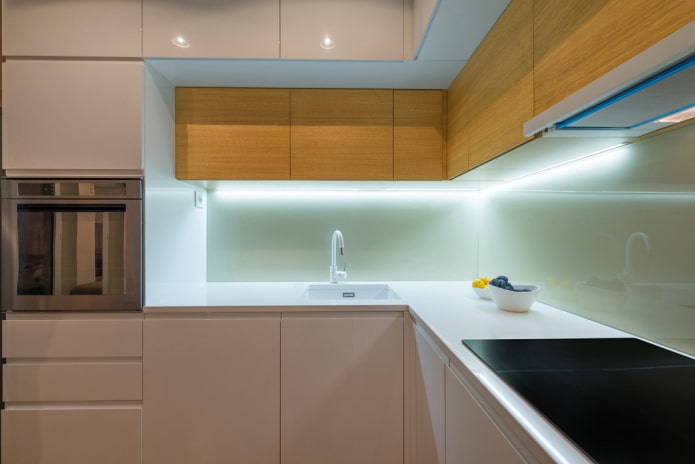
 10 practical tips for arranging a small kitchen in the country
10 practical tips for arranging a small kitchen in the country
 12 simple ideas for a small garden that will make it visually spacious
12 simple ideas for a small garden that will make it visually spacious

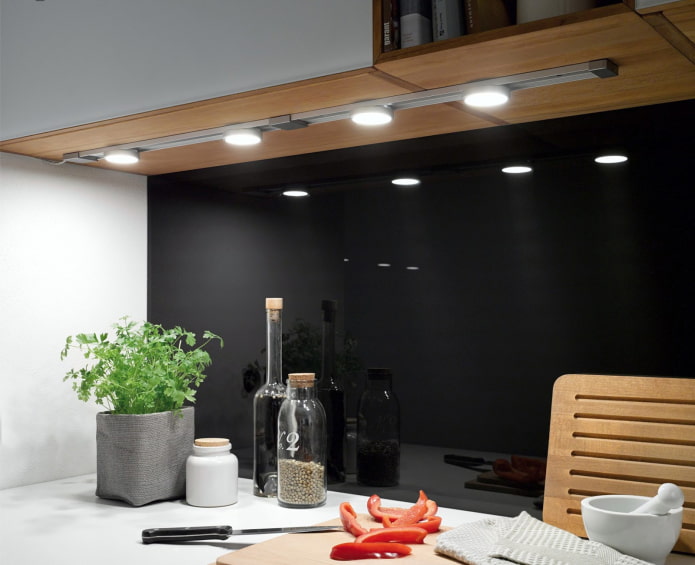
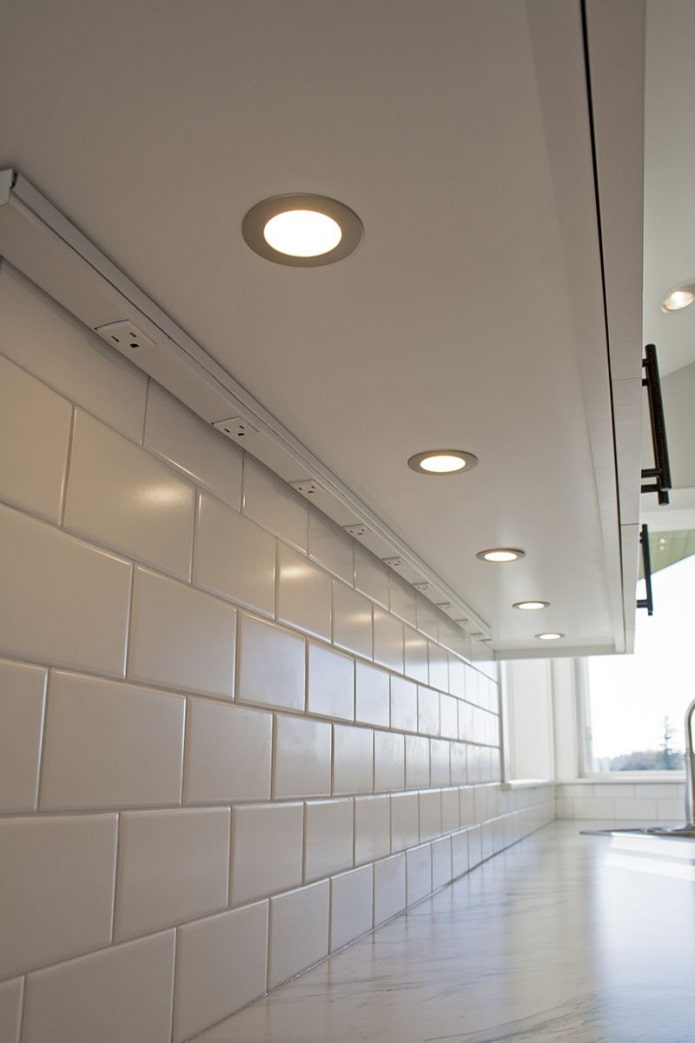
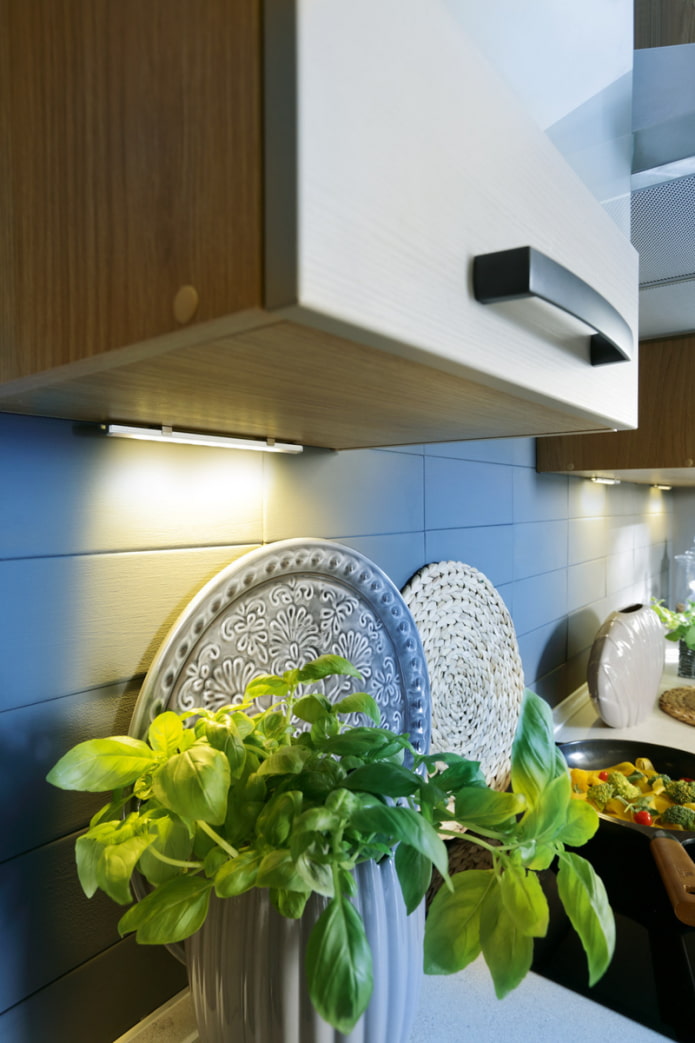
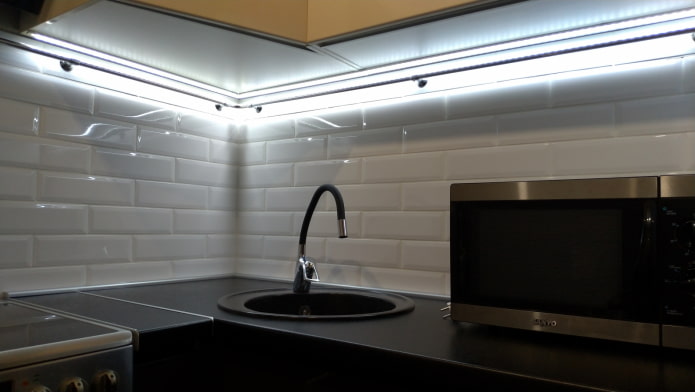
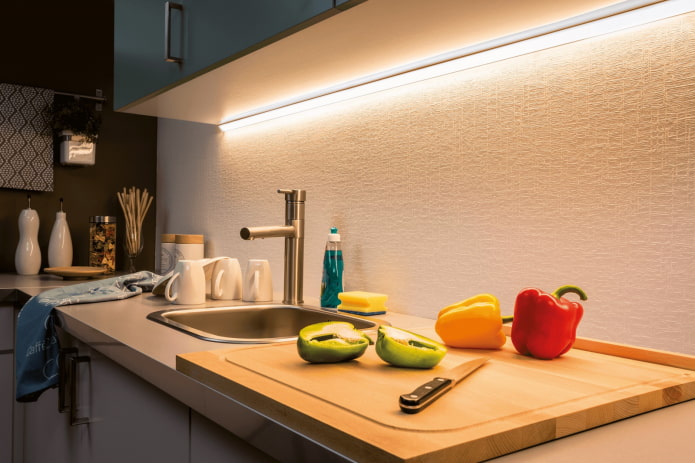
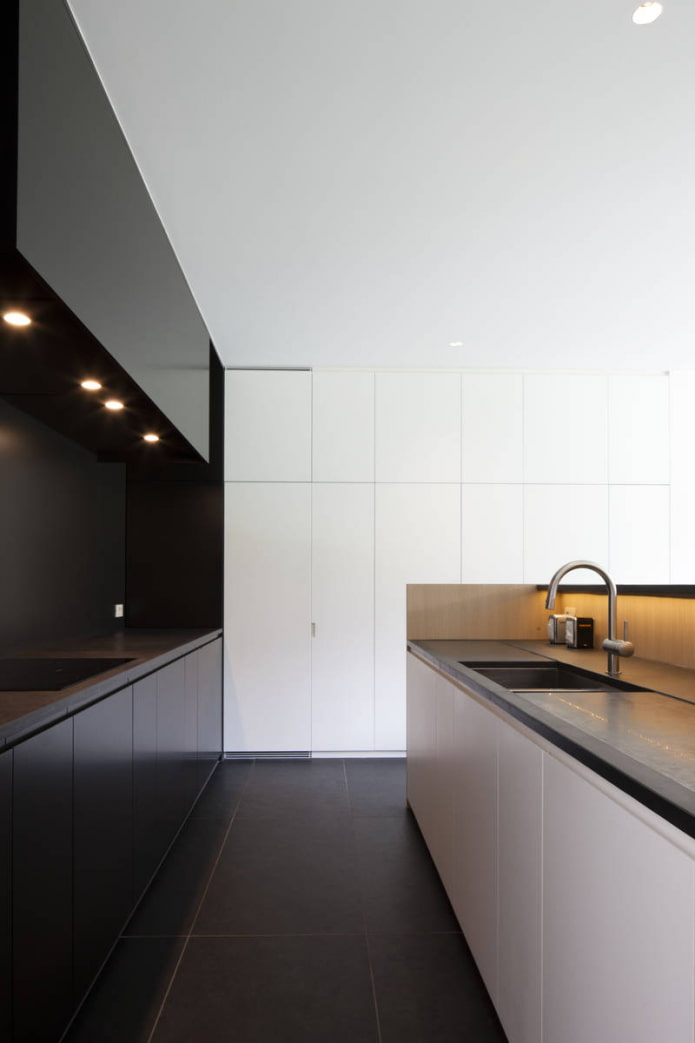
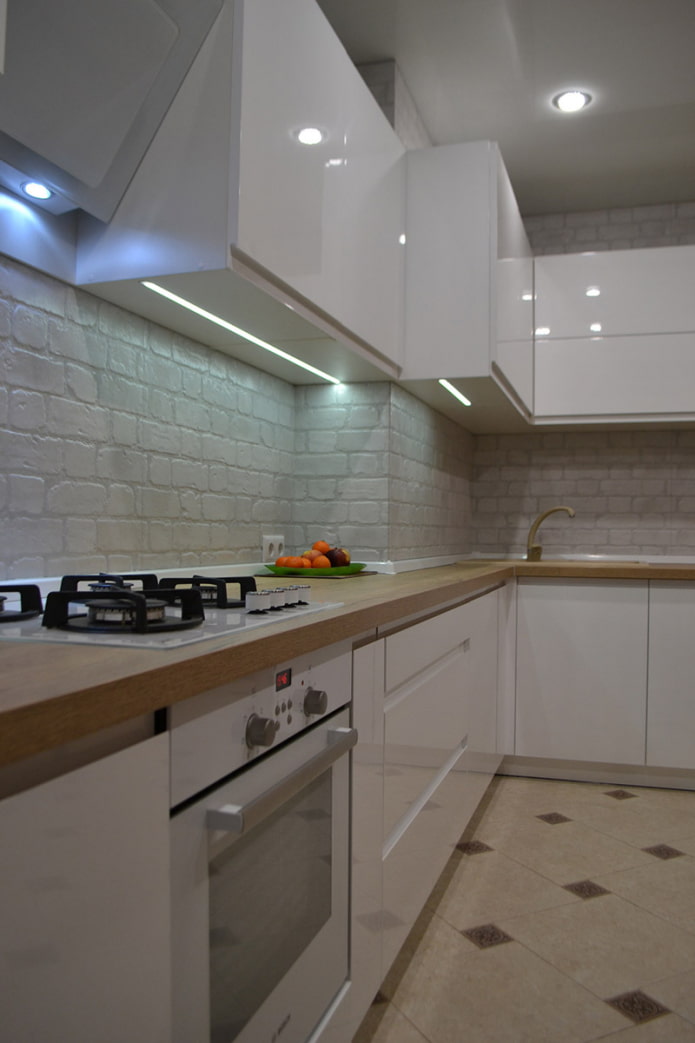
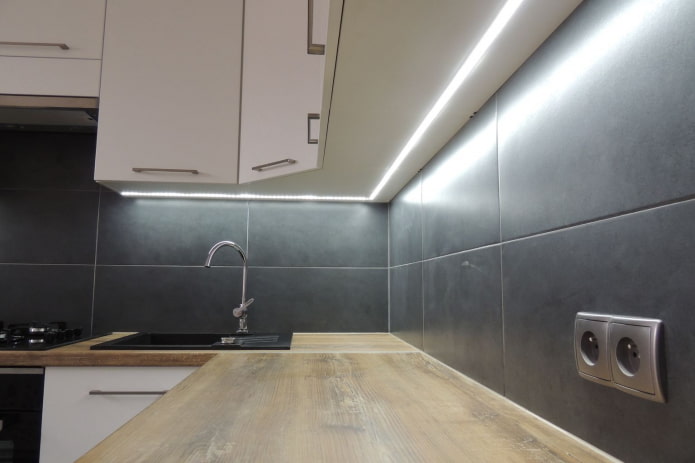
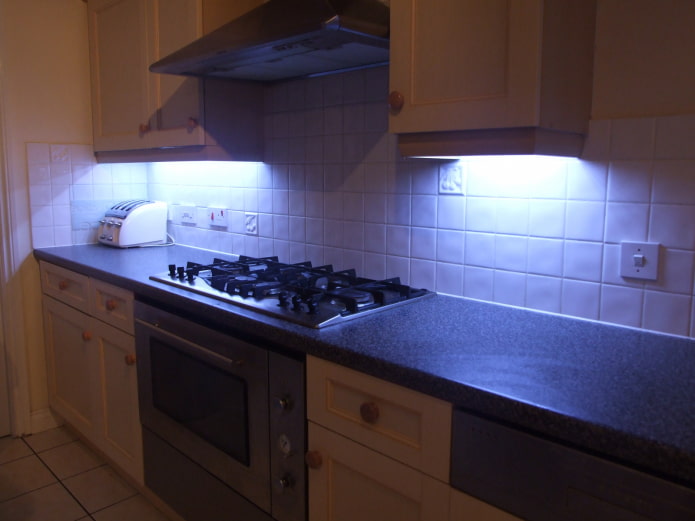
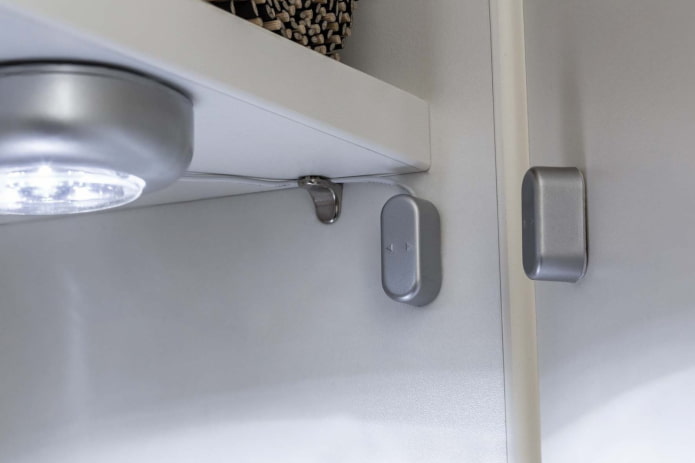

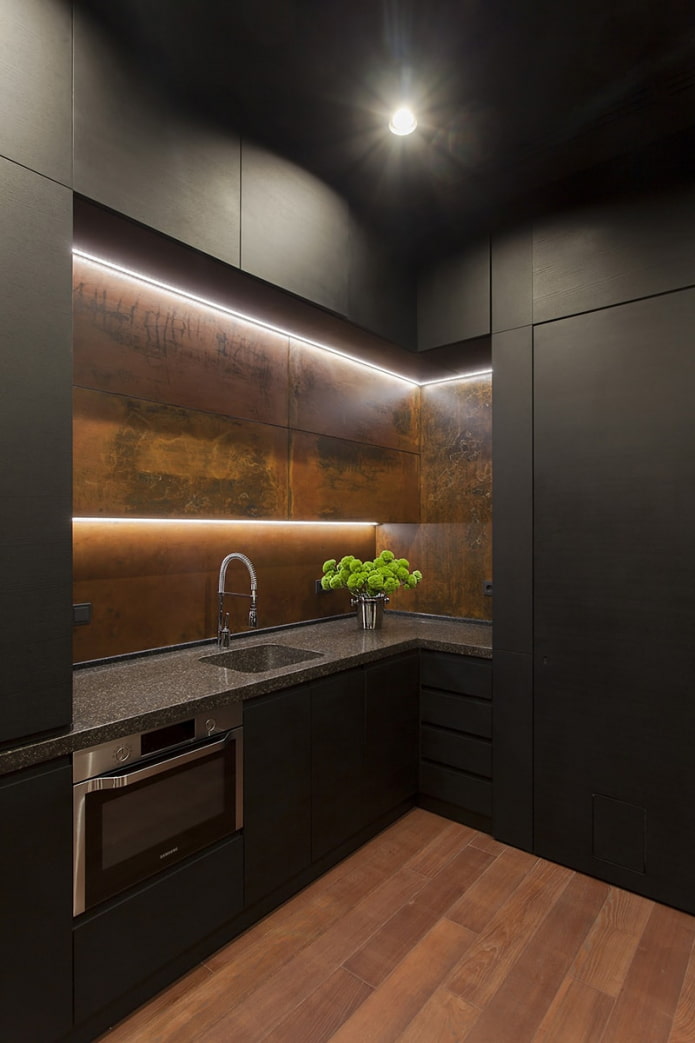
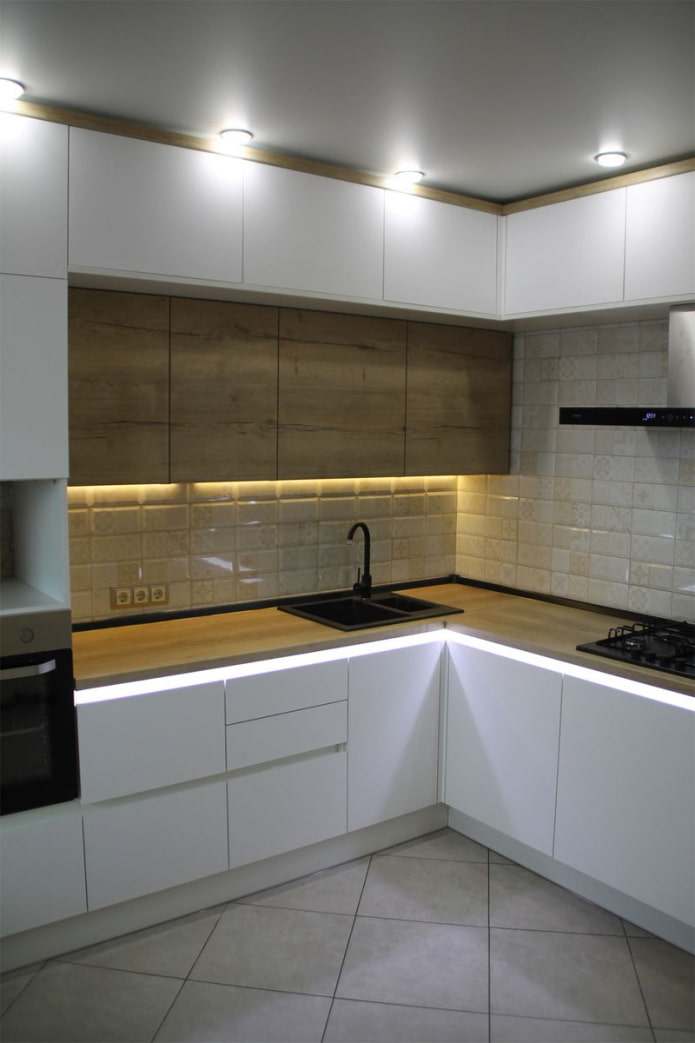
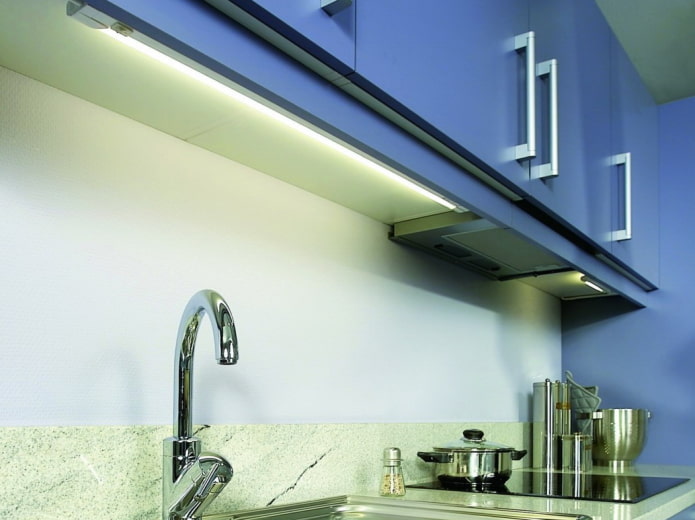

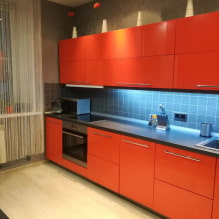
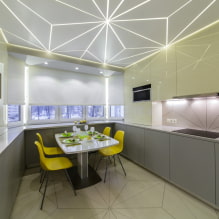
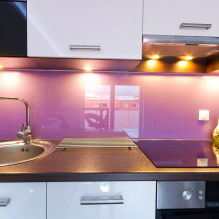
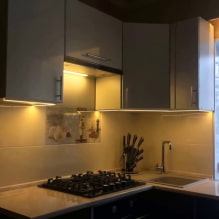
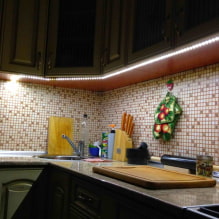
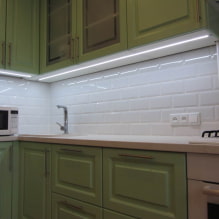
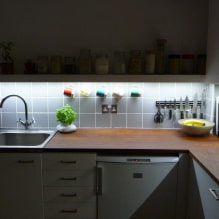
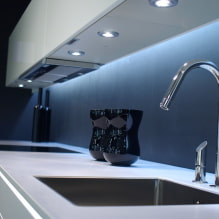

 How to choose the color of your kitchen sink?
How to choose the color of your kitchen sink? White kitchen set: features of choice, combination, 70 photos in the interior
White kitchen set: features of choice, combination, 70 photos in the interior Black set in the interior in the kitchen: design, choice of wallpaper, 90 photos
Black set in the interior in the kitchen: design, choice of wallpaper, 90 photos How to choose curtains for the kitchen and not regret it? - we understand all the nuances
How to choose curtains for the kitchen and not regret it? - we understand all the nuances Design of a white kitchen with a black countertop: 80 best ideas, photos in the interior
Design of a white kitchen with a black countertop: 80 best ideas, photos in the interior Kitchen design with green wallpaper: 55 modern photos in the interior
Kitchen design with green wallpaper: 55 modern photos in the interior